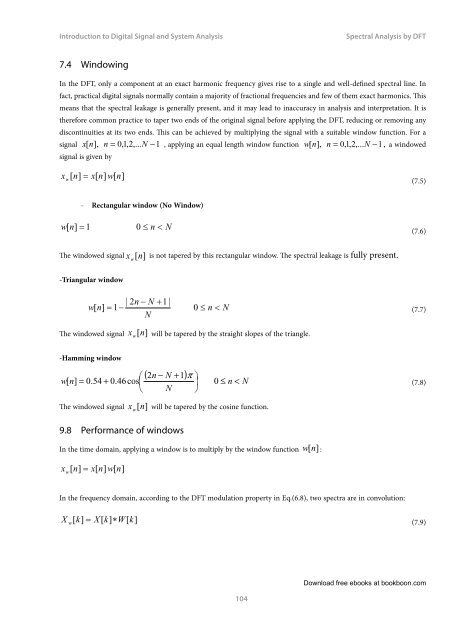Introduction to Digital Signal and System Analysis - Tutorsindia
Introduction to Digital Signal and System Analysis - Tutorsindia
Introduction to Digital Signal and System Analysis - Tutorsindia
You also want an ePaper? Increase the reach of your titles
YUMPU automatically turns print PDFs into web optimized ePapers that Google loves.
<strong>Introduction</strong> <strong>to</strong> <strong>Digital</strong> <strong>Signal</strong> <strong>and</strong> <strong>System</strong> <strong>Analysis</strong><br />
Spectral <strong>Analysis</strong> by DFT<br />
7.4 Windowing<br />
In the DFT, only a component at an exact harmonic frequency gives rise <strong>to</strong> a single <strong>and</strong> well-defined spectral line. In<br />
fact, practical digital signals normally contain a majority of fractional frequencies <strong>and</strong> few of them exact harmonics. This<br />
means that the spectral leakage is generally present, <strong>and</strong> it may lead <strong>to</strong> inaccuracy in analysis <strong>and</strong> interpretation. It is<br />
therefore common practice <strong>to</strong> taper two ends of the original signal before applying the DFT, reducing or removing any<br />
discontinuities at its two ends. This can be achieved by multiplying the signal with a suitable window function. For a<br />
signal x [ n],<br />
n = 0,1,2,... N −1<br />
, applying an equal length window function w [ n],<br />
n = 0,1,2,... N −1, a windowed<br />
signal is given by<br />
x w<br />
[ n]<br />
= x[<br />
n]<br />
w[<br />
n]<br />
(7.5)<br />
--<br />
Rectangular window (No Window)<br />
w [ n]<br />
= 1<br />
0 ≤ n < N<br />
(7.6)<br />
The windowed signal x w<br />
[n]<br />
is not tapered by this rectangular window. The spectral leakage is fully present.<br />
-Triangular window<br />
| 2n<br />
− N + 1|<br />
w [ n]<br />
= 1−<br />
0 ≤ n < N (7.7)<br />
N<br />
The windowed signal x w<br />
[n]<br />
will be tapered by the straight slopes of the triangle.<br />
-Hamming window<br />
( 2n<br />
− N 1)<br />
+ π <br />
w [ n]<br />
= 0.54 + 0.46cos<br />
0 ≤ n < N (7.8)<br />
N <br />
The windowed signal x w<br />
[n]<br />
will be tapered by the cosine function.<br />
9.8 Performance of windows<br />
In the time domain, applying a window is <strong>to</strong> multiply by the window function w [n]<br />
:<br />
x w<br />
[ n]<br />
= x[<br />
n]<br />
w[<br />
n]<br />
In the frequency domain, according <strong>to</strong> the DFT modulation property in Eq.(6.8), two spectra are in convolution:<br />
X w<br />
[ k]<br />
= X [ k]<br />
∗W[<br />
k]<br />
(7.9)<br />
104<br />
Download free ebooks at bookboon.com
















